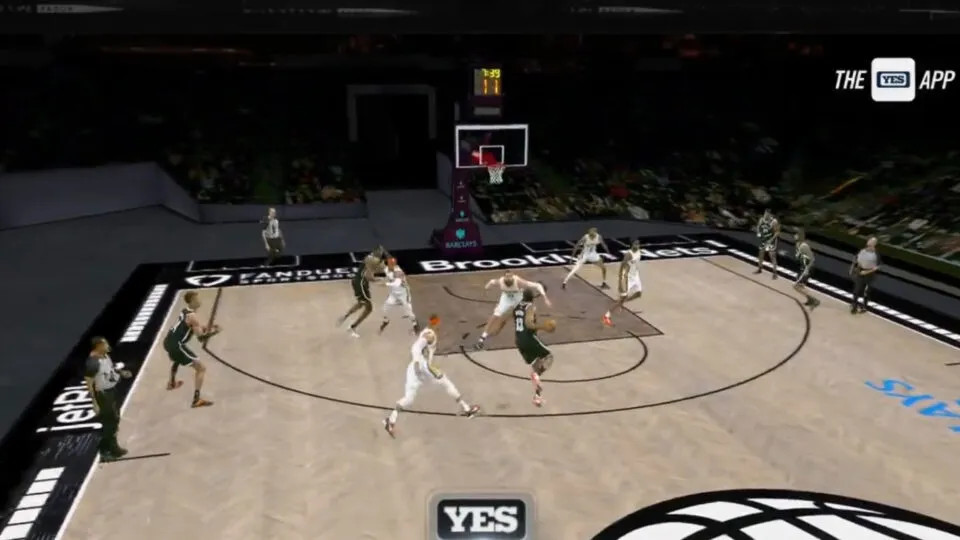Gamification in Broadcast: It’s All About the Eyeballs
Advanced visuals that resemble video game graphics in broadcast, especially within sports, are everywhere

This year, for the first time in history, linear tv viewing numbers dropped dramatically while streaming numbers soared. Dwindling viewership numbers, the shift to streaming, and changing consumption habits of the younger generations all present a series of challenges for broadcasters.
However, it’s not all doom and gloom, there are ways to change your content to better increase eyeball count, and incorporating more advanced game-like visuals is a winner.
What is gamification in broadcast?
Gamification is defined as the process of adding games, or game-like elements to something (such as a task) so as to encourage participation. If we think about this concept in terms of broadcast, it is realistically the use of game-design elements and game principles in non-game contexts to drive audience engagement.
This can include features like incorporating advanced graphics that track players, display real-time analytics as on-screen graphics and player stats, live chat interactions, viewer polls, and other engaging elements to enhance the viewer experience.
It’s all about making the broadcast more interactive and entertaining for the audience, drawing inspiration from the captivating and immersive world of video games.
But does gamification in broadcast work?
I read an article the other day, about the Bachelorette. For Season 20, which had significantly lower audience numbers during its premiere than Season 19, introduced a series of interactive games in the hopes to drive viewer engagement.
The aim was to encourage the audience to predict outcomes, analyze cast members’ choices, voice opinions, and engage deeper with the content to add excitement and immersivity for those tuning in.
Interestingly, it achieved a 94.5% first-click engagement rate, showing the appeal and fascination behind these types of interactive ‘gamified’ experiences. Over 45% of the viewers who saw the games participated.
The results speak for themselves, but the concept of adding game design, game like elements and advanced visuals to broadcasts isn’t new. Which begs the question, why is it reemerging now?
History of game-design elements in broadcast
Introducing game-design elements in broadcast started years ago. The digital first down line, or the ‘yellow line’ in football was introduced in 1998. This simple, software-driven graphic helped viewer accessibility and supported an enhanced visual experience. The graphic showed viewers clearly that this team needs to get to this line, or they lose possession.
In 2001, ESPN enhanced the viewer experience for Major League Baseball with the introduction of the ‘K Zone’ box. It was a simple graphic that calculated each batter’s speed, and displayed where the ball crossed the hitter’s strike zone. Other sports like NASCAR followed suit shortly after adding real-time object tracking to moving cars providing information like gear position, rotations per minute, and fuel consumption.
The 2010s saw the creation of more cutting-edge game-like technology that could achieve advanced real-time analysis, telestration, 3D augmented reality (AR) flights and graphics, and replay.
And in 2014, came RFID (radio frequency identification) tracking, used by the NFL and NBA, to collect more data from players, and officials like speed, location, distance traveled, acceleration, and it’s all being updated in real-time, about 10x per second.
The use of real-time data driven graphics in broadcast in a gamified style has grown since the early days. Advanced visuals that resemble video game graphics in broadcast, especially within sports, are everywhere. See how many you notice when you’re next watching television.
One of the reasons for the resurgence is because technology has caught up to the demand and direction that broadcasters have envisioned, a secondary reason is the need to appeal to a new generation of fans.
Changing viewer habits: Gen Z and millennials
Linear broadcast and viewer numbers are dropping because they are in competition with digital devices and social media consumption. A recent survey about sports viewer habits revealed that 80% of fans between the ages of 18 and 26 typically watch sports from their mobile phones—with 74% getting most of their sports content from social media.
And over half of Gen Z (67%), those born in the late 1990s to early 2000s, soon to be the dominant demographic, prefer consuming sports content on their phones while on the go. Gen Z also stated they are opting for mobile phone viewing as a whopping 37% access all their content via mobile devices due to accessibility (54%), convenience (46%), and the ability to multitask (43%).
The same survey found that 77% of younger viewers (Gen Z and millennials) consider analysis created with AR graphics, virtual studios, and data as essential to their viewing experience. And approximately 79% of sports fans felt more interested in the content, and more likely to watch a broadcast if graphics and virtual elements like augmented reality graphics, virtual studios, data analysis and replay were used.
More than that, 57% of viewers were more likely to watch content for longer if virtual elements were used, and this increased to 63% for Gen Z respondents. 29% of those surveyed also agree that graphics and virtual elements added to a sports broadcast make them more likely to watch that broadcaster’s coverage in the future.
Broadcasters must adapt to serve and connect with these digital native audiences to not only capture their eyeballs but convert them into loyal viewers and lifelong fans. This is where advanced AI, analysis, data integration, virtual studios, AR, and 3D graphics, and telestration tools come in as game-like elements to engage.
Video game style visuals, what’s next?
For the past few years now, video game style graphics have become incredibly advanced. Just look at the viral video of Carolina Panthers’ giant augmented reality panther which paced the stadium and tore up a New York Jets flag from 2021, or the 49ers opening the Nickelodeon Super Wild Weekend with a giant AR slime monster.
In 2022, the Brooklyn Nets introduced the "netaverse" with 110 high resolution cameras to generate realistic renderings in seconds so viewers could direct the camera themselves in the virtualized CG court, with the ability to see angles that were never possible before.
This was real-life 2K playing out for fans that could take the game into their control and connect in a completely new way. Whereas video games used to be dramatically different than the quality of broadcast, the quality of both has risen. The worlds of virtual reality and reality have become increasingly intertwined and nearly indistinguishable from each other.
I suspect that we will see more experimentation in this space across other broadcasts, and as the technology becomes more democratized, even tier two and three broadcasters and more niche sports will begin trialing these technologies. It may also be that we take the interactivity side of audience engagement one step further with graphics, and viewers watching from home will be able to create and personalize their experiences by controlling the graphics on their phones, or via a second screen.
AI driven analysis being mapped to graphics is also likely to increase even in the next year or so, with AI functionality increasing rapidly. For example, the NBA is already using a predictive graphic that calculates the percentage of a player’s probability of making the shot at that specific part of the floor, in real-time leveraging AI for its analysis.
We could see entire alternative feeds driven by AI or predictive plays that determine what will happen next based on retrospective data and footage, taking commentary and analysis, and thus the audience experience to an entirely new level. The use of AI could be used to create more accurate betting predictions and help give advice and deeper insight into betting placement.
Really, the possibilities of including more "gamified" elements into broadcast are endless—but the limitations aren’t on the imaginations of the creatives, it’s the technology that must catch up. Whereas incorporating game-like graphics started simple, it’s extended beyond a line, or a box graphic. Creative visual storytelling via game-like graphics is about providing additional intimate insights, statistics, visuals, and interactive platforms to deliver and truly connect with viewers.
The viewers of today, and tomorrow want unique and engaging experiences that capture their attention so completely that the passive act of watching television is transformed into something more interactive, entertaining, and immersive. The game for broadcasters is to capture the eyeballs, and it’s constantly changing and innovating—are you sure you’re performing at the top of yours?
Get the TV Tech Newsletter
The professional video industry's #1 source for news, trends and product and tech information. Sign up below.
Pino Barile is Head of Sports, USA for Vizrt. Pino is a seasoned professional with over 25 years of experience in the world of broadcast technology. Throughout his career, he has been a driving force behind the success of some of the industry's largest Tier 1 vendors and customers. Pino's passion lies in helping organizations create innovative solutions and workflows that elevate their storytelling capabilities to new heights. Currently serving as the Head of Sports, AMECS at Vizrt, Pino is at the forefront of revolutionizing the way broadcasters, teams, leagues, venues and more engage and immerse audiences. In this pivotal role, he brings to bear his deep technical knowledge of streaming media, video-over-IP, broadcast, cloud environments, live production, extended reality, and graphics.

